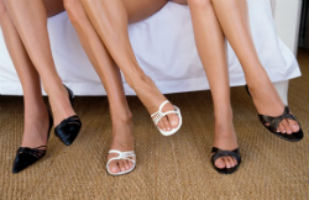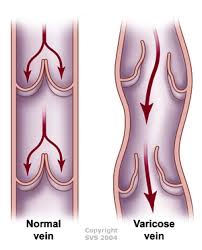10 Rules of Life for Patients with Varicose Veins
The term “varicose veins” most commonly refers to the veins in the lower extremities because such veins mostly develop in legs, but actually they can occur elsewhere. According to the statistics, varicose veins affect about 55% of women and 45% of men. About 50% of the patients suffering from this condition have inherited it. If both of your parents have varicose veins, then your chances of developing this condition are close to 90%. In the case of one parent affected, the chances of a daughter are about 60%, and those of a son – 25%.
Factors that influence the development of this predisposition:
-
- Lifestyle. The risk group includes people with occupations that require them to stand or sit long hours, like hairdressers, drivers, software engineers, etc.
- Clothing. Vascular spiders may appear at any age. Those people who prefer tight jeans are at a greater risk because tight clothes form a kind of a venous tourniquet – the arterial blood can pass easily, but is much harder for the venous blood to return.
- Pregnancy. Varicose veins appear as a result of hormonal changes, decrease in collagen level and increase in intra-abdominal pressure.
How to recognize the disease?
If, by the end of your working day, you feel heaviness in your legs and your favorite shoes become too tight because of swelling in the legs and feet, then these are the first signs. You may also experience cramps in your legs and pains in the calves from time to time.2 The first symptoms of varicose veins also include feeling warmth and burning in the legs along the veins. Noticeable changes in the veins usually start in a small way – spider veins.
What people with varicose veins need to pay attention to:
 Compression garments - stockings in particular. An important condition for the treatment and prevention of venous insufficiency is the use of high-quality and properly sized compression stockings, knee-length socks and tights. It’s better to put on such garments in the morning, after light gymnastics or before you get out of bed. You should remove compression garments before going to bed at night.
Compression garments - stockings in particular. An important condition for the treatment and prevention of venous insufficiency is the use of high-quality and properly sized compression stockings, knee-length socks and tights. It’s better to put on such garments in the morning, after light gymnastics or before you get out of bed. You should remove compression garments before going to bed at night.- Active lifestyle. Regular 2-hour walks at a pace most comfortable for you, cycling, swimming and aerobics help stimulate the venous outflow from the lower extremities which prevent venous congestion. However, you should avoid anything involving jumping, squatting, and any exercises using weights. By no means should you lift heavy objects. It’s worth remembering that, in the case of apparent varicose veins, you should exercise with your shins bandaged with elastic bandage or by wearing compression stockings. Once the workout is over, lie down for a few minutes with your legs raised above the level of your head.
- Thermal procedures. Hot baths or mud-baths, sauna and overexposure to the sun reduce the venous tone and lead to the congestion of blood in the legs and therefore should be avoided.
- Comfortable clothes and shoes. It’s recommended to wear comfortable and loose clothes. Women should try to avoid high heels giving preference to comfortable shoes with 1-1.5 inches heels.
- Body position. Varicose veins can be caused by standing for long periods of time, so try to shift your weight from one leg to another if you must stand. Long-term sitting can be harmful as well; thus, try to get up and move around the room from time to time. It’s also important to sit properly – do not slouch, do not cross your legs, etc.
- Water procedures. Every morning when washing your face and hands, pay some attention to your legs as well. Pouring cool water over your legs and feet as well as having contrast showers are very helpful. In the evening have a 10-minute foot bath with sea-salt or herbal decoctions.
- Proper diet. Your diet should contain a maximum of vegetables and fruit, and a minimum of salty and smoke-dried food. Spicy food makes the blood thicker and that leads to the formation of clots. The same is true for alcoholic beverages. It’s recommended to eat meat as little as possible and reduce the consumption of salt. Drink green tea, juices and fruit drinks. As for coffee, have not more than 2 cups per day and preferably with milk. Scientists have proven that garlic has a positive effect on the blood - it prevents the formation of blood clots that could block blood flow.
- Proper rest for your legs. When resting or even sleeping, it is helpful to raise your legs a little (2-3 inches). You can either lift the foot of your bed or put a cushion or bolster under your legs. Try to hold your legs high when reading or watching TV. To improve blood circulation in your legs, rotate your feet and toes for 3-5 minutes before going to bed at night and after waking up in the morning.
- Body weight. It’s essential to control your body weight because excess weight has a negative influence on the course of the disease. If you are overweight, you should maintain a low-calorie diet.
- Massage. Everyday massage, including stroking the legs starting from the lower leg and moving upwards. This is good for those who are predisposed to varicose veins but are not yet diagnosed. But, if you’ve been already diagnosed with this condition, you should avoid massaging the problem areas.
Recreational and remedial gymnastics
You can benefit from certain daily exercises:
-
-
- Rising on your toes. The starting position – stand straight, your feet together and parallel to each other. On the count of ‘one’ – go up on your toes, on the count of ‘two’ – get down to the starting position. Repeat 20-30 times.
- Rising on your toes (first position). The starting position – stand straight with your heels touching and toes pointing out to the sides. Follow the instructions from the previous exercise.
- Rising on your toes (heels apart). The starting position – stand straight with your toes touching and heels pointing out to the sides. It will look like some kind of a “pigeon-toed position”. On the count of ‘one’ – go up on tiptoe, on the count of ‘two’ – return to the starting position. Repeat 20-30 times.
- Bicycle (lying on your back). Lie on your back and start moving your legs as if you are riding a bicycle. Be sure to fully extend your legs with each pedal.
-
References:
-
-
- Varicose Veins Statistics. http://chicagoveininstitute.com/varicose-veins-statistics/
- What are the symptoms of varicose veins? Edinburgh vein study cross sectional population survey. http://www.bmj.com/content/318/7180/353?variant=full-text
- J T Hobbs. ABC of vascular diseases. Varicose veins. http://www.ncbi.nlm.nih.gov/pmc/articles/PMC1670946/pdf/bmj00145-0053.pdf
- Varicose Veins: Diagnosis, Management, and Treatment. http://www.medscape.com/viewarticle/826296_7
-










